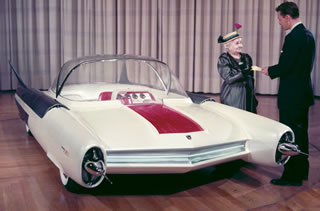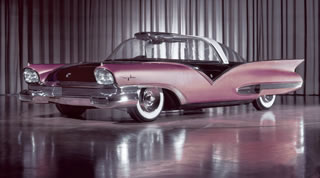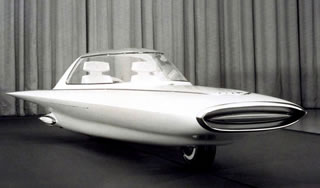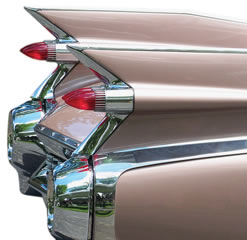Adventure on Wheels - Page 5
Among the most-striking Ford-Ghia collaborations is the Ghia Selene Two, designed by Exner's son, Virgil Jr., in 1962. It looks more space capsule than car—and far more stylish than anything John Glenn rode.
 |
 |
 |
|
|
Detroit's third major manufacturer, Chrysler, was known in the '50s for cars that were well-built and high performance, but dowdy. "Competition cars in a Brooks Brothers suit," Adler called them. Dunn believed Chrysler was still feeling burned from its failure with the curvaceous Airfow, a 1934 production car that scared buyers off because it was ahead of its time.
But when it came to concept cars throughout the '50s, Chrysler did all right. Who can argue with the Dodge Firearrow, which went through several iterations starting in 1953, a sexy little Exner sports car that's sleek and smooth and catlike?
The DeSoto Adventurer, a swoopy-lined concept car a year later, soon went into production. Another charmer was the 1956 Chrysler Dart, with a retractable ('roof-o-matic') hardtop roof.
Dream cars did produce innovations that were adopted in production cars, including retractable hardtop convertibles, wraparound windshields, and power windows. Several dream cars actually entered full production, in toned-down form, including the Corvette and Avanti. And perhaps most importantly, says Dan Dunn of the Blackhawk Museum, dream cars provided society with a sense of style and adventure.
 |
|
|
So where is that sense of adventure today?
Judging by most cars on the road, the dream has died.
Already, by the mid-1960s, the over-the-top days of chrome and tailfins were gone. "During the '60s," Brown says, "cars got away from the space-age optimism they had in the 1950s. They got away from the airplane and rocket motif. They got sleeker and sleeker."
Today, people care about cost, they care about fuel economy—and they care about style. But car design just isn't as exciting as it was in the '50s.
Why are today's cars boring?
 |
 |
|
edge fins, was the quintessential motoring icon of the ‘50s. |
|
 |
|
|
Dunn suggests an explanation he heard from a retired car designer. "He said, somewhere along the way accountants took over. There are good designers out there. But the decision is to stay safe."
Brown has another explanation. "In a word, regulations." Safety rules that began in the early 1970s control a car's design, from 'crumple zone' to bumper height. "Once you start building cars around the regulations," he says, "all the cars start looking kind of the same."
Photos: courtesy General Motors LLC 2011, Jaspar Fleming collection, John Oliver, Rik Hoving, Joe Bortz
Special thanks to John Kyros of General Motors Media Archive




